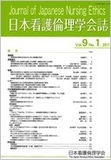Japanese
English
- 販売していません
- Abstract 文献概要
- 参考文献 Reference
目的:看護管理者の臨床倫理ガイドライン導入の取り組みと、ガイドライン導入による看護管理者やチームの認識や行動の変化を明らかにする。方法:臨床倫理ガイドライン試行に参加した看護管理者10名を対象者とし、半構成的面接で得たデータを質的帰納的に分析した。結果:対象者の導入の取り組みと対象者が認識した変化として【導入に対する管理者の意識】【管理者が行った導入のための段取り】【管理者からスタッフへの働きかけ】【ガイドラインの活用方法】【管理者・チームの変化】の5カテゴリーが見いだされた。考察:臨床倫理ガイドラインには看護職に重要なことを想起させるreminderの機能や、日々のケアの振り返り、道標としての機能を有することが示唆された。また、導入により対象者やチームの倫理的感受性の向上や行動の変化があったと考えられた。チーム全体で倫理を中心に考えるために看護管理者が意思表明をする重要性が示唆された。
Objective: To elucidate the efforts of nurse managers in the implementation of the Clinical Ethics Guidelines, as well as changes in the awareness and behavior of nurse managers and teams due to implementation of the Guidelines. Methods: Subjects were 10 nurse managers who participated in the implementation trial of the Clinical Ethics Guidelines, and the data obtained from semi-structured interviews were analyzed qualitatively and inductively. Results: A total of five categories were identified for the efforts of subjects in the implementation and the changes perceived by subjects: “awareness of managers regarding implementation”, “arrangements made by managers for the implementation”, “approaches made by managers toward staff”, “method of use of the Guidelines”, and “changes in the managers and teams”. Discussion: These findings suggest that the Clinical Ethics Guidelines have the functions of reminding nursing staff of important matters, and serving as a guide that enables daily reflections of care. The implementation was also thought to have resulted in an improved ethical sensitivity and behavioral changes in the subjects and teams. These findings indicate that in order for the entire team to focus on ethics, it is important for nurse managers to communicate with the team.
Copyright © 2017, The Japan Nursing Ethics Associatin. All rights reserved.


